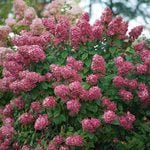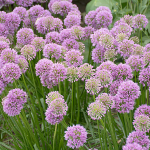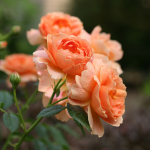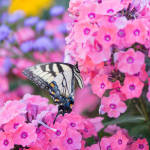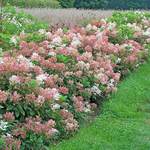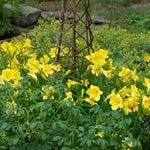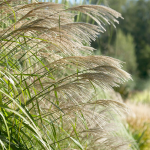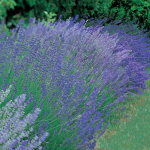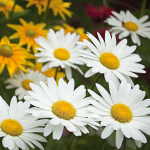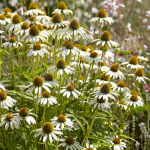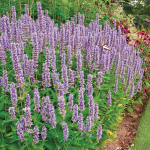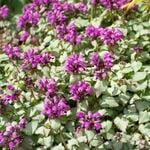Product Details
Here's instant gratification from a perennial—this new Coneflower blooms the first year, bringing color all summer long from 3–4" blossoms, with occasional flowering until frost. Because the plant branches from the base, it also produces more flower stems. Echinacea purpurea PowWow® Wild Berry has great color, too: brilliant rose-purple petals circle the typical orangey brown cone. A 2010 All-America Selections® Flower Award Winner. 'PAS702917'
Echinacea, a North American genus in the Daisy family, has big, bright flowers that appear from late June until frost. Coneflowers thrive in average soils or hot, dry conditions and shrug off cold. Blooms last well, cut or dried, and the seeds in the large cone at the heart of the flower head provide nourishment for birds. Coneflowers are equally at home in formal borders or cottage gardens. Deer resistant.
For more information on growing and care, click on Growing Guide.
How to see a 3D model of this item
1. Click on the 3D Model image in the image gallery.
2. A pop up will open with the 3D model of the item. You can move the 3D model around with your mouse if on a computer or with your finger on your device. The 3D model represents a mature plant that is approximately 3 years old.
How to use (AR) Augmented Reality to see this item in your garden1. Make sure your device has a camera and is connected to the internet. If you want to see the item in your garden and are on your computer, click the 3D Model image on your computer and a QR code will open that will allow you to open the link on your device.
2. Once you have clicked the 3D Model image on your device, go outside and face your device camera toward where you would like to see how the item will look in your garden.
3. To see the item in your own garden, click on the [AR] link in the lower right-hand corner of the screen. You might need to wait a few seconds for the AR experience to load. This only works from a device with a camera such as a mobile phone or a tablet.
4. Allow your device to access the camera, if prompted.
5. Point your device's camera at the area where you want to place the plant or garden.
6. The website will use Augmented Reality to place a virtual image of the item in the space you are looking at through your device’s camera. You can adjust the position of the virtual item by using two fingers to resize the item, or one finger to move the item around the screen, until you're satisfied with how it looks. To get an accurate sense of the size of this item, we recommend measuring out the area where you would like to plant it (the spacing for this item is 16-18"), and staking or flagging the borders so that you will have an accurate idea for the mature size of the item while using AR (the magnifier only enlarges the 3D model of the item, it does not change the actual size of the item). The 3D model represents a mature plant that is approximately 3 years old.
7. Move your device around to view the item from different angles and get a better idea of how it will look in your garden.
8. Once you have everything lined up, take a screenshot or tap the screen to show the AR experience controls and press the white circle to take a photo of the AR image to save it for future reference.
9. If you decide to purchase the item, you can use the AR image as a reference for placement in your garden.
Shipping
HOW PLANTS ARE SHIPPED
The size of the plants we ship has been selected to reduce the shock of transplanting. For some, this means a large, bareroot crown. Others cannot travel bareroot or transplant best if grown in containers. We ship these perennials and annuals in 1 pint pots, except as noted. We must point out that many perennials will not bloom the first year after planting, but will the following year, amply rewarding your patience. We ship bulbs as dormant, bare bulbs, sometimes with some wood shavings or moss. Shrubs, Roses, vines, and other woody plants may be shipped bareroot or in pots. The size of the pot is noted in the quick facts for each item.
WHEN WE SHIP
We ship our bulbs and plants at the right time for planting in your area, except as noted, with orders dispatched on a first-come, first-served basis by climate zone. We also ship a wide range of containers and planters, tools, supplies, fertilizers, garden wear, garden decor items, as well as indoor decorations like wreaths and dried bouquets when available. Estimated dates for shipping are indicated in the green Shipping Details box for each item. Please supply a street address for delivery. Kindly contact us with two weeks notice, if you'll be away at the expected time of delivery.
OUR GUARANTEE
We guarantee to ship plants that are in prime condition for growing. If your order is damaged or fails to meet your expectations, we will cheerfully replace or refund it. Please contact our Customer Service Department at 1-800-503-9624 or email us at [email protected]. Please include your order number or customer number when contacting us.
Reviews
Average Customer Rating:
 (9 Reviews)
Write a Review
(9 Reviews)
Write a Review
Sort by:
No Blooms 
hippieluver from Kannapolis, NC
Didn't bloom 
MHH from Upper State NY
Didn't grow! 
patty from Greentown, IN
23 of 24 people found this review helpful. Do you? yes no Certified buyer
Growing guide
Latin Name Pronunciation: ek-in-ay'see-uh
These sturdy perennials bloom from early summer until frost. Butterflies revel in the flowers and the seed heads are beloved of goldfinches. Easy to grow and trouble-free, Coneflowers are at home in the wild garden as well as in the more refined perennial border, and make ideal cut flowers. Please note: So plants may properly establish before winter, we recommend early fall planting of Echinacea in colder zones (Zones 5 and lower).
Light/Watering: Flowering is at its best in full sun, although plants will tolerate light shade. Deep taproots make these plants quite drought-tolerant once established.
Fertilizer/Soil and pH: Applying a couple inches of organic matter, such as compost or well-rotted manure, around the plants in early spring will take care of nutritional needs; no further fertilizing will be necessary. Echinacea purpurea is adaptable to most soil types but prefers a sandy, well-drained loam and a pH from 6.0 to 7.0.
Pests/Diseases: Echinacea is rarely troubled by pests or diseases, none serious enough to warrant control measures. Plants do attract beneficial insects, especially firefly-like soldier beetles, which feed on aphids and caterpillars.
Companions: Shorter perennials camouflage occasional basal legginess; compact varieties of Catmint (Nepeta) are ideal companions as are perennial Geraniums, dwarf Goldenrods (Solidago), and Salvia. Taller companion plants include Perovskia, Phlox, Sedum, Veronica, and Monarda.
Reflowering: Echinacea has a long bloom season even without deadheading, but that practice will result in more blooms. Plants can be cut back by half in early summer, resulting in a later bloom time but more compact form. Leave some seed heads to provide food for goldfinches -- there are few sights more delightful than watching the small, golden birds wave about as they pick out the seeds.
Dividing/Transplanting: Plants rarely need dividing, and transplanting older plants can be tricky due to the taproot. It can be done, however, as long as you dig deeply and keep a good amount of soil around the roots.
End-of-Season Care: Plants may be left standing through winter as the seeds heads collect the snow in pretty little puffs.
Calendar of Care
Early Spring: Divide or transplant now, watering well afterward.
Late Spring: Provide supplementary water only if the season is extremely dry or if the Coneflowers are newly planted.
Summer: Deadhead if desired, but leave some seeds for the goldfinches. Watch for beneficial soldier beetles in August and do not harm them. Plants may be cut back by half in June; this will result in later-flowering, more compact growth.
Fall: A light mulch in colder regions is beneficial.

